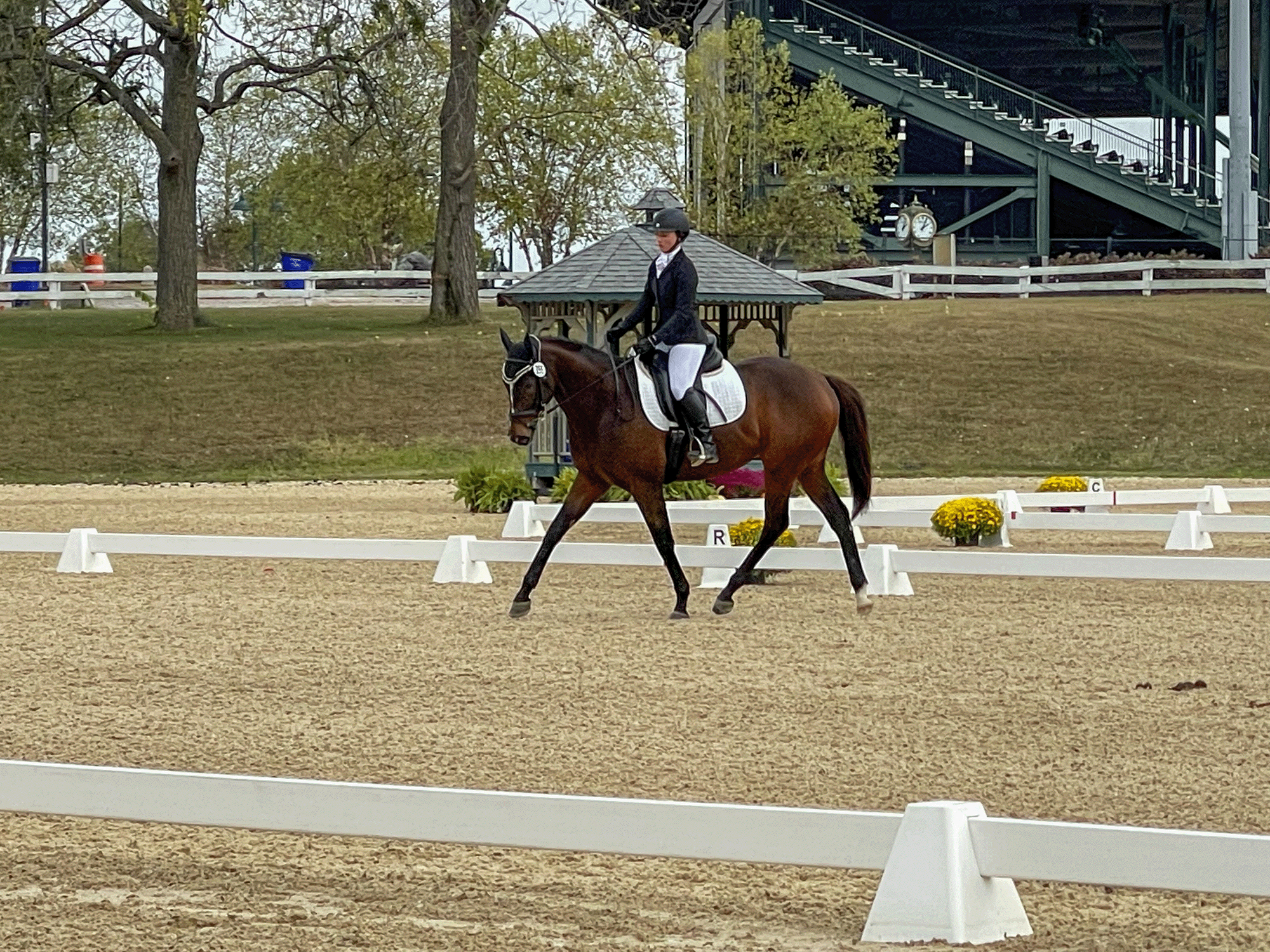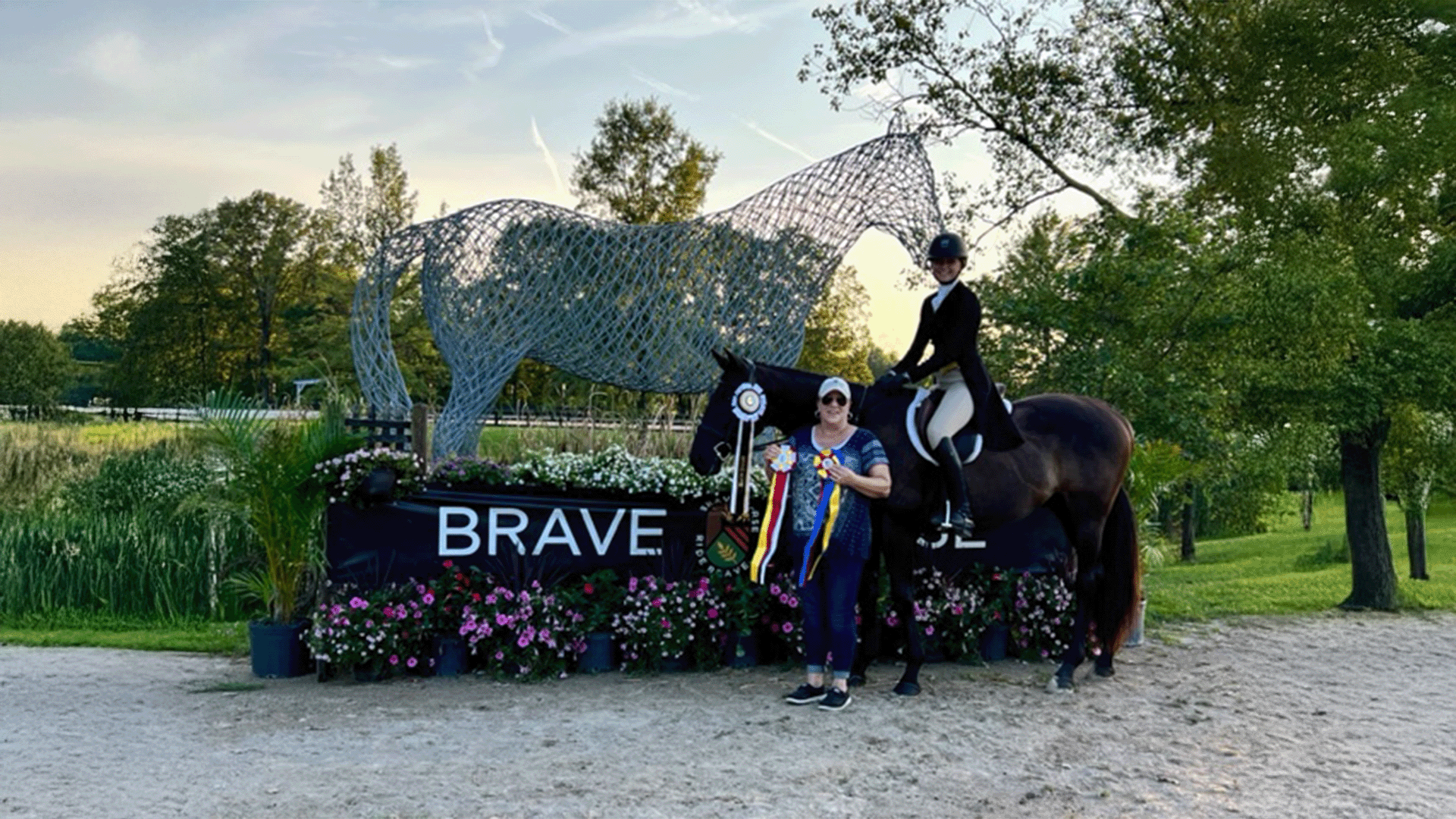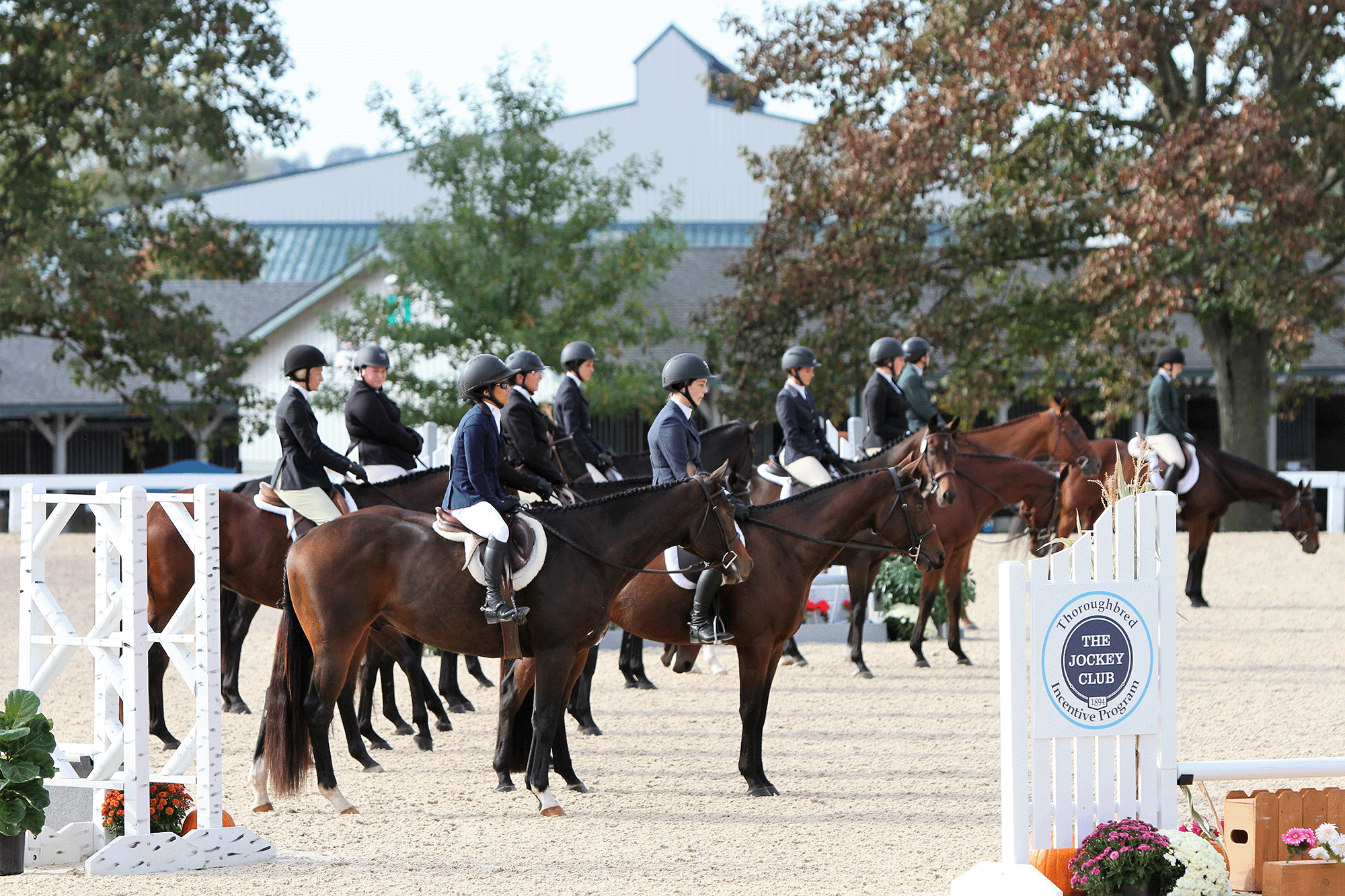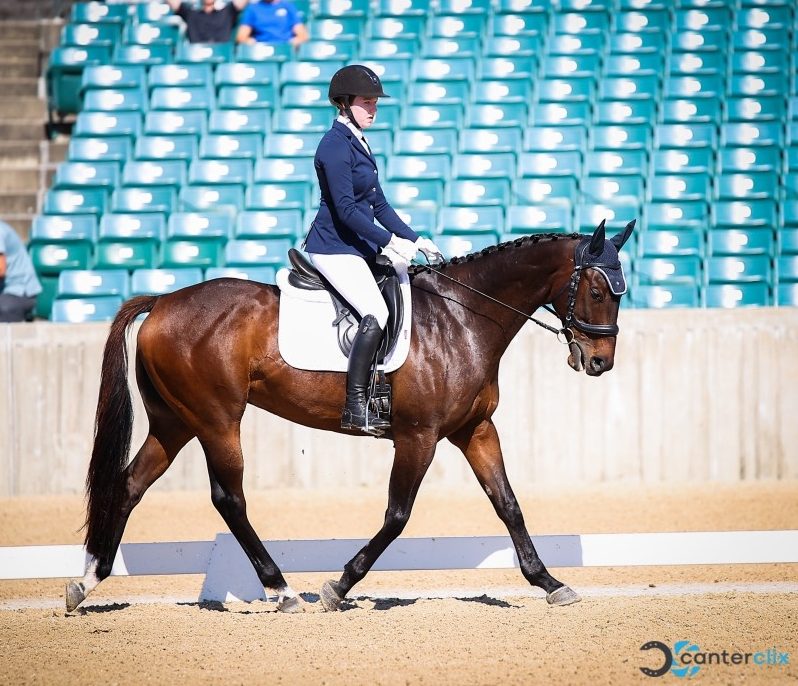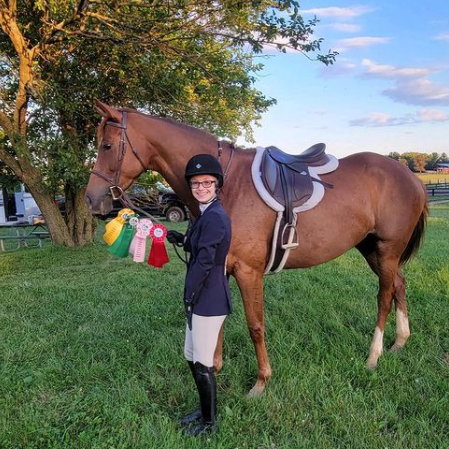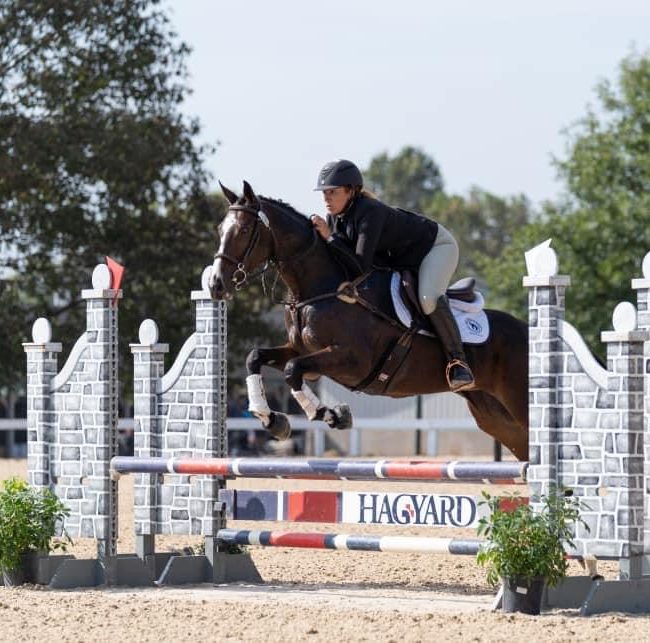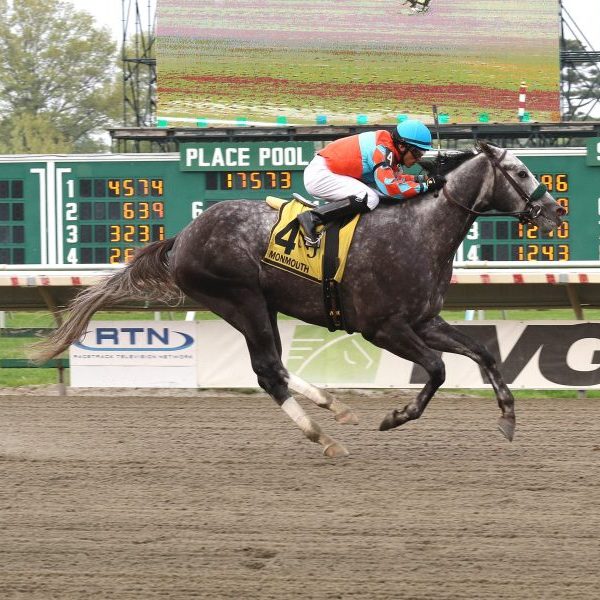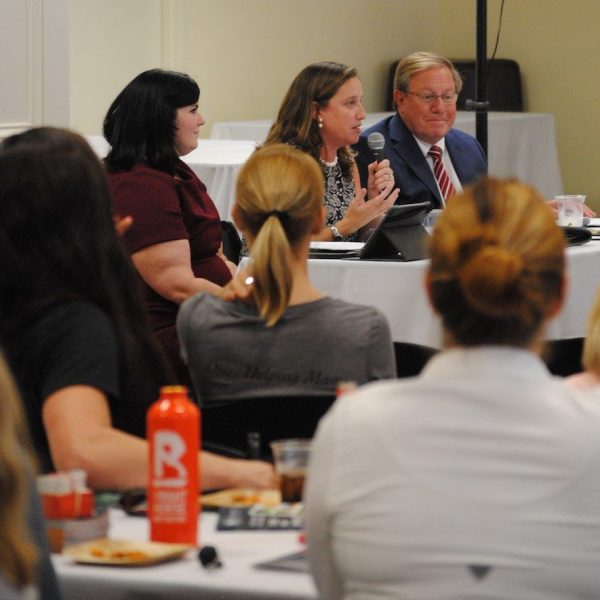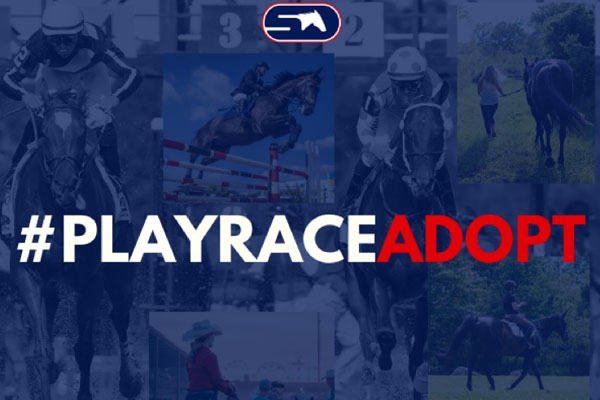Retired Racehorse Project
All Posts & News Press Releases Success Stories Aftercare Editorials Retraining Tips Supporter Features Inspector Spotlights Hamburger Toggle Menu Previous Post Getting to Know Outbound Getting to Know Outbound By: Alexis Arbaugh March 13, 2025 Success Stories Tags:accredited aftercare, Accredited Organization, Eventing, Retired Racehorse Project, RRP, The Secretariat Center, Thoroughbred Aftercare Alliance Gabrielle Pearce developed a passion for horses at a young age, starting with ponies. As her confidence in the saddle grew, she transitioned to off-the-track Thoroughbreds. One of her earliest experiences with an ex-racehorse was riding Mr. Martini, an older Thoroughbred known for his calm and level-headed demeanor. He became the perfect bridge between ponies and larger horses, helping Gabrielle build the confidence and skills necessary to become a successful rider. After the unfortunate passing of Mr. Martini, Gabrielle found Vinnie, a 6-year-old off-the-track Thoroughbred who had received approximately 60 days of professional retraining. Since Vinnie had already been restarted, he seemed like the ideal next step in Gabrielle’s journey toward retraining an ex-racehorse on her own. “Vinnie was an exceptional athlete who genuinely enjoyed having a job,” Gabrielle recalled. He loved learning new things, and each lesson seemed to carry over to the next ride, as if he remembered everything they did. Their partnership developed quickly, deepening as they learned and grew together. A few years ago, Gabrielle tragically lost Vinnie in an accident, leaving her heartbroken and uncertain about whether she would ever find another horse as special as he had been. When she finally resumed her search, she felt most comfortable adopting a horse from an accredited aftercare organization. Gabrielle had a great experience with the Secretariat Center, a Thoroughbred Aftercare Alliance-accredited organization in Lexington, Kentucky. The organization listened to her needs, never pressured her, and provided honest assessments of each horse. Gabrielle’s list of “must-haves” included a horse at least 16 hands tall, free of prior injuries that could impact training, without cribbing habits, and possessing a calm personality. After trying a few horses, she left undecided. However, when she returned a couple of months later for additional trial rides, she had a gut feeling that Outbound, nicknamed “Porter,” was the perfect match for her. In October 2022, Gabrielle adopted Porter, who at the time had only five retraining rides. “He is the youngest and greenest horse I have owned,” she said. The 16-hand bay gelding is Kentucky-bred by Candy Ride (ARG) out of Zofzig (Danzig). He raced only twice at Horseshoe Indianapolis in Indiana, earning $1,215. As soon as Gabrielle brought Porter home to her family farm, she turned him out alone in a pasture, expecting him to run or buck after the long trailer ride. Instead, he calmly wandered around the field, grazing and quietly taking in his new surroundings. When it came time to meet the other four geldings on the farm, Porter showed no interest in causing trouble. He quickly integrated into the herd, and they all got along seamlessly. Gabrielle’s decision to take on all of Porter’s retraining herself became a valuable learning experience. Her previous show experience, along with lessons and clinics, gave her the foundation she needed to restart a horse. However, she also understood that learning never stops. When she found herself stuck or looking for fresh ideas, YouTube videos and Instagram accounts became valuable resources. Gabrielle feeds Porter Tribute Senior Sport, supplemented with a small amount of Tribute Essential K and Lubrisyn HA. In the winter, she incorporates timothy or alfalfa cubes into his meals to help maintain a healthy weight. Throughout the day, Porter enjoys a mixture of grass hay to complement his diet. Gabrielles goal for Porter was to enter him into the 2023 Retired Racehorse Project. Gabrielle had to carefully plan his training schedule, making sure not to exceed the maximum number of allowed rides as outlined by the competition’s rules. Gabrielle’s first focus was one groundwork, aiming to build mutual respect. She understood that while developing a bond with a horse is important, it should never lead to the horse disrespecting or taking advantage. Establishing this respect created a solid foundation for their under-saddle training. Gabrielle also wanted to teach Porter the fundamentals of being a well-mannered horse. One of their key challenges was getting Porter to stand still at the mounting block. Together, they worked on building up his patience, training him to wait calmly for Gabrielle’s cue before walking on after she mounted. Another hurdle was helping Porter become comfortable with the farrier. As with mounting, he struggled to stand still, but over time, he learned that the farrier was there to help, not harm him. Gabrielle also emphasized spatial awareness to reinforce the importance of respecting each other’s personal space. SEE RELATED RE-TRAINING TIP FEATURE: “Getting Started with Groundwork & Manners for Your Ex-Racehorse” Click HERE for Retraining Tip Feature An essential part of their groundwork involved the use of pressure and release. For example, when Gabrielle applied gentle pressure on the reins, Porter would respond by turning his head, and she would immediately release the pressure as a reward. They also practiced moving his body laterally, using pressure to guide him in the desired direction and releasing it once he responded correctly. This method significantly improved their communication, helping Porter become more responsive and attentive to Gabrielle’s cues. Clipping had been a work in progress, particularly around Porter’s ears, which are often sensitive areas for horses. Many horses dislike having their ears touched, but Gabrielle took a patient, gradual approach to help Porter become comfortable with clippers on all parts of his body. Her steady method ensured he remained relaxed throughout the process. Trailering can be challenging for many horses, even those with previous travel experience like racehorses. Each trailer is slightly different, and that unfamiliarity can cause anxiety. Encouraging a horse to calmly enter and exit what might seem like a dark, intimidating box requires patience. Gabrielle committed to a slow and steady approach, prioritizing Porter’s comfort and confidence throughout the process. Like many young
Read More >All Posts & News Press Releases Success Stories Aftercare Editorials Retraining Tips Supporter Features Inspector Spotlights Humberger Toggle Menu Previous Post manhattan striker Manhattan Striker By: Alexis Arbaugh September 27, 2024 Success Stories Tags:accredited aftercare, CANTER, CANTER Michigan, Eventing, hunter jumper, Retired Racehorse Project, RRP TIP, TAKE2, Thoroughbred Aftercare Alliance, Thoroughbred Incentive Program “This has been a life-changing experience for my daughter and has shaped her in more ways beyond just in the saddle,” shared Sara Anderson. Sara Anderson and her 11-year-old daughter, Anna Huard, were searching for a horse that could become a long-term equine partner and compete in the 2018 Retired Racehorse Project (RRP). They turned to CANTER Michigan because it offered potential adopters the chance to meet and ride horses before adoption. Upon their visit, they were introduced to Manhattan Striker by CANTER Michigan’s head trainer, Jennifer Blades. Manhattan Striker, an Australian-bred black Thoroughbred gelding, had raced 23 times and earned $39,750 in Hong Kong. After his racing career ended, he was part of a group of 12 horses donated to CANTER Michigan. When Sara and Anna first met Manhattan Striker, he wasn’t the warm and affectionate horse he is today. His paperwork from the track noted that he cribbed, stall-walked, and had a generally grumpy attitude. The barn staff at Willowbrooke Farm, the facility where he was housed, had to be cautious when handling him. Despite these quirks, Sara described him as having a “serious and quiet demeanor,” which soon proved to be a great match for Anna’s personality. Manhattan Striker quickly bonded with Anna, taking an immediate liking to her. Sara observed that he seemed solid and balanced under saddle, and Anna saw potential for a long-term partnership. Although he remained grumpy during grooming, once he came home, he stopped cribbing and stall-walking altogether. He soon became sweet and affectionate with Anna and the other children at the barn. His temperament mellowed so much that he even became a suitable turnout companion for weanlings. Anna had ambitious goals for herself and Manhattan Striker, affectionately known as “Manny.” She wanted a versatile partner she could train to compete in multiple disciplines and develop a close bond with. Manny exceeded her expectations. “The retraining process was interesting,” Sara recalled. Manny wasn’t overly hot and adapted quickly to everything he was asked to do. Their goal was to enter the 2018 RRP, and Sara allowed Anna to take the lead in his training. While Manny initially lacked a lead change, he mastered it after just one lesson. “He’s been great for my daughter because she’s been able to teach him things, and he responds and learns the way you hope they will,” Sara said. Manny always tries his best and doesn’t hold a grudge if Anna makes a mistake. Through their journey together, Anna learned the value of patience and building a solid foundation with her horse. At horse shows, Manny was a dream. “No AM lounge, no hard schooling. No trainer rides, no perfect prep or ear plugs. He doesn’t even wear a martingale to mess with. Goes in a simple rubber D. He doesn’t need to see the ring before going into a class. Light warmup, a few jumps, and in he goes,” Sara wrote. Manny was also easy to load and handle at shows, and Anna could braid and prep him herself. Screenshot Although Manny isn’t the best mover, making it tough to place in hack classes, he shines as a jumper. He thrives in equitation and medal classes, excelling at technical tracks, halts, and counter-cantering. “He’s able to take the harder courses and do all the fun things,” Sara said. Anna and Manny successfully competed in the Hunter division at the 2018 RRP. They continued training and later competed in local 2’6″ Hunter classes. For a change of pace, they also enjoyed eventing. In 2022 and 2023, the pair competed in the Take2 Thoroughbred divisions and the 15-17 equitation division with notable success. Anna and Manny were named the 2023 Overall Top Junior Rider in the Take2 Hunter division and placed 9th in the Take2 Finals. “We’re also thankful for Thoroughbred-specific opportunities like the RRP, Take2, and TIP, which give kids like mine a supportive community,” Sara wrote. Manny has surpassed all the goals Anna set for him, and they have formed a strong bond along the way. Looking ahead to 2024, they plan to continue competing in the Take2 Hunter divisions and enter more equitation and medal classes during Anna’s final junior year. This past July, Anna and Manny were selected to participate in the United States Hunter Jumper Association (USHJA) Emerging Athletes Program at St. Mary-of-the-Woods College in Indiana, where Manny stood out as the only Thoroughbred. Share This Article Do you have a success story that you would like to share? Submit your experience with an accredited organization here: Success Story Submission
Read More >All Posts & News Press Releases Success Stories Aftercare Editorials Retraining Tips Supporter Features Inspector Spotlights Humberger Toggle Menu Previous Post Moab’s Journey to the RRP Moab’s Journey to the RRP By: Alexis Arbaugh September 27, 2024 Retraining, Success Stories Tags:accredited aftercare, Godolphin, hunter jumper, Retired Racehorse Project, The Thoroughbred Makeover, Thoroughbred Aftercare, Thoroughbred Aftercare Alliance Moab was donated to The University of Findlay (UF) in the spring of 2023 by Godolphin, one of the world’s leading Thoroughbred breeding and racing operations. Godolphin, also a proud supporter of Thoroughbred Aftercare Alliance, is profoundly invested in the aftercare of Thoroughbreds. For years, Godolphin has supported UF’s breaking and retraining program by donating horses, highlighting their commitment to Thoroughbred aftercare. At the start of the fall semester, Ryanne, a junior in the English Equestrian Program, was assigned to work with Moab. In this program, students take full responsibility for a horse’s care and riding each semester. As they progress, students may be assigned multiple horses and are encouraged to break or retrain young horses after their freshman year. Moab, a 2020 bay gelding by Street Sense out of Skylighter, didn’t race but received some initial under-saddle training before arriving at UF. Ryanne felt relieved that she didn’t have to start from scratch, though retraining an ex-racehorse can still be challenging. Fortunately, this wasn’t Ryanne’s first experience working with a green or unbroken horse. During her sophomore year, she spent time at Findlay’s Western Farm, where she worked alongside students and trainers to break colts. Ryanne’s passion for horses began at age eight, starting with Hunter/Jumper lessons before progressing to dressage until she was 18. After high school, she enrolled at The University of Findlay and joined the English Equestrian Program, where she trained under the Hunter/Jumper coach. Most recently, Ryanne spent the summer in Wellborn, Florida, working with a variety of horses—broke, green, and unbroke—honing her skills with different levels of training. When Moab arrived at The University of Findlay, he was given time to settle into his new surroundings. By mid-August, his training with Ryanne began. Despite Moab’s calm demeanor on the ground, they approached the retraining process slowly and carefully. They worked in the detached indoor arena, where young and unbroke horses are started due to its quieter environment. Like all Findlay students, Ryanne began Moab’s training in the round pen to maintain better control. She started with lunging and eventually taught him how to line drive. Understanding the importance of forward motion in horse training, Ryanne focused on ensuring that Moab moved forward and responded to her aids, knowing that this would lay the foundation for further success. When Ryanne felt that Moab was ready to be ridden, she mounted him for the first time. Mounting can be tricky if the horse hasn’t been properly handled beforehand. To keep him calm, she had a classmate hold him while she mounted, helping Moab stay relaxed. Teaching him to stand still after mounting took time, but with patience, Moab eventually learned to wait for Ryanne’s cue to walk off. Now, mounting is easy and doesn’t faze either of them. After mounting, Ryanne’s priority was establishing forward movement and straightness. Encouraging forward motion helps the horse focus on “thinking forward” and paying attention to the rider’s aids. Straightness improves the horse’s balance and body awareness, helping them understand where all four legs are in relation to each other. These foundational elements are crucial for Moab’s training and overall responsiveness to Ryanne’s cues. While Moab’s under-saddle training progressed, Ryanne also focused on refining his ground manners. She introduced him to clippers and mane pulling, both of which he tolerated well, standing calmly during grooming sessions. They also worked on trailer loading, which he handled without any issues, further proving himself to be an all-around easy-going horse. Moab did have one quirky habit—he loved to put everything in his mouth. From blankets to Ryanne’s clothes, if it was within reach, Moab would try to chew on it. Like many young horses, this behavior stemmed from curiosity, as licking and chewing help them explore their surroundings. However, if left unchecked, it could lead to unwanted biting or nipping. Gradually, Moab began to learn that chewing on toys and treats was acceptable, but clothes—his or Ryanne’s—were off-limits. After achieving straightness, Ryanne focused on more advanced training, including teaching Moab to respond to bit pressure and use his body more efficiently. Moab excelled in these challenges, eagerly responding to Ryanne’s cues. Before long, he became strong enough to lift his back while being ridden and carry himself properly. He learned to bend and flex without losing balance, though it was more challenging for him at the trot and canter than at the walk. By taking things slow and steady, Moab was able to learn correctly, always showing a desire to do the right thing. At this stage, Ryanne recognized that Moab needed more mental stimulation. She decided to introduce ground poles as the next challenge in their preparation for the Retired Racehorse Project. Walking, trotting, and cantering over the poles didn’t bother Moab at all, so Ryanne began teaching him how to jump. Moab seemed to enjoy it, treating it like a fun game, so she continued raising the jumps and challenging him with more complex exercises and combinations. With the Retired Racehorse Project approaching, they worked diligently on lateral movements for the dressage test and perfected their 2’6″ fences for the show Hunter courses. Ryanne soon knew that Moab was ready to compete in The Retired Racehorse Project because his response time under saddle became quick and dependable. “There was no longer a conversation—I’d ask, and he’d respond with ‘yes ma’am,’” Ryanne wrote. Another sign of his readiness came when one of her classmates rode him, and Moab performed just as well for her as he did for Ryanne. It was clear that all the pieces of their training were falling into place, and Moab was fully prepared for the show. Competing at The Retired
Read More >All Posts & News Press Releases Success Stories Aftercare Editorials Retraining Tips Supporter Features Inspector Spotlights Humberger Toggle Menu Previous Post Thoroughbred Aftercare Alliance On-Site at The Retired Racehorse Project’s Thoroughbred Makeover Thoroughbred Aftercare Alliance On-Site at The Retired Racehorse Project’s Thoroughbred Makeover FOR IMMEDIATE RELEASE October 4, 2024 News Tags:accredited aftercare, Kentucky Horse Park, Retired Racehorse Project, Thoroughbred Aftercare, Thoroughbred Aftercare Alliance, Thoroughbred Makeover LEXINGTON, KY — Thoroughbred Aftercare Alliance will be on-site as a sponsor this year for The Retired Racehorse Project’s banner event, the Thoroughbred Makeover and National Symposium. The Thoroughbred Makeover takes place at the Kentucky Horse Park in Lexington, KY on October 9-12, 2024, and is the largest retraining competition for recently retired Thoroughbred racehorses. This event showcases the versatility and adaptability of these athletes as they transition into new careers, highlighting the importance of aftercare in ensuring successful second careers for Thoroughbreds. Thoroughbred Aftercare Alliance will have a booth located in the Covered Arena during the Thoroughbred Makeover. Riders and patrons are encouraged to stop by to learn more about accredited aftercare and the role it plays in the future of retired racehorses. In addition, branded merchandise will be available at the booth in exchange for donations, offering supporters a way to contribute to accredited aftercare which supports the ongoing care and retraining of these amazing Thoroughbreds. Out of the 353 horses entered in this year’s Thoroughbred Makeover, 53 horses will be representing 11 Thoroughbred Aftercare Alliance accredited organizations. These horses will be competing in 8 of the 10 disciplines offered at the event. “Thoroughbred Aftercare Alliance is thrilled to be a sponsor of The Thoroughbred Makeover,” said Stacie Clark Rogers, Operations Consultant, Thoroughbred Aftercare Alliance. “Both Thoroughbred Aftercare Alliance and The Retired Racehorse Project are deeply committed to facilitating the retraining and rehoming of these incredible athletes. The Thoroughbred Makeover is a wonderful opportunity to showcase the remarkable second careers these horses can have.” About Thoroughbred Aftercare Alliance Based in Lexington, KY, Thoroughbred Aftercare Alliance is a 501(c)(3) nonprofit that accredits, inspects, and awards grants to approved aftercare organizations to retrain, retire, and rehome Thoroughbreds using industry-wide funding. Along with continued funding from its original partners Breeders’ Cup, The Jockey Club, and Keeneland Association, Thoroughbred Aftercare Alliance is supported by owners, trainers, breeders, racetracks, aftercare professionals, and other industry members. Since its inception in 2012, Thoroughbred Aftercare Alliance has granted more than $31.9 million to accredited aftercare organizations. Currently, 86 aftercare organizations comprised of approximately 180 facilities across North America have been granted accreditation. To learn more about Thoroughbred Aftercare Alliance, visit thoroughbredaftercare.org. Contact Thoroughbred Aftercare Alliance 859-224-2756 info@thoroughbredaftercare.org Fundraising & Events Emily Dresen 352-362-6934 edresen@thoroughbredaftercare.org Media Contact Samantha Smith Share This Release
Read More >The day Peyton Place broke his maiden, he caught the eye of TAA-accredited MidAtlantic Horse Rescue Executive Director, Bev Strauss.
Read More >After six starts on the track, Jardin de Giverny never broke her maiden. In 2020, the four-year-old began the next chapter of her life at TAA-accredited MidAtlantic Horse Rescue. After rehoming thousands of former racehorses, Executive Director Bev Strauss has had plenty of experience transitioning Thoroughbreds off-the-track. “When Jardin came in it was obvious she was a total athlete with a good brain, but needed a program and direction,” Strauss said. “So, we sent her to Sally Shirley for a consistent program.” The Kentucky-bred was off to begin retraining for her second career at Shirley’s Westminster, Maryland farm. Meanwhile, a young Sarah Laderman had just begun the search for her first horse. At the age of eight, Sarah rode a horse for the first time thanks to father who enrolled her in a week-long day camp. It wouldn’t be long before she was taking lessons and entering competitions. Her father, Steve, recognized early on that his daughter’s passion for horses was serious, and eventually he agreed it was time for Sarah to have a horse of her own. “Sarah has a fairly natural ability to handle herself around horses and I was confident in her ability to train and bring a horse along,” Steve Laderman said. Sarah had done her research and decided she would be looking specifically at off-track Thoroughbreds— something MidAtlantic had in spades. “I saw the ad for MidAtlantic Horse Rescue on Facebook,” Sarah said. “I checked out their website and found Jardin.” A couple days later Sarah and her dad were on their way to Sally Shirley’s farm, ready to meet Jardin de Giverny. “She was almost exactly what I was looking for,” Sarah said. “She was a really pretty mover which stood out to me, but it was that she was willing to learn and picked up on things really quickly that convinced me.” Just three months after arriving at MidAtlantic, the daughter of Superfly had found her forever home. Sarah and Jardin stayed in Shirley’s training program for a month to give the new partnership a good foundation and to work out those OTTB quirks— something Steve Laderman has enjoyed watching from the sidelines. “It has been crazy watching Sarah and Jardin grow as a team and both being able to anticipate each other’s movements and actions,” Steve said. “The amount of trust and comfort level continues to build as we go and Jardin’s maturity is beginning to shine through. That trust has helped tremendously in Jardin’s transition to her new life as a show horse. Sarah and Jardin earned 15th place in the Show Jumping division at the 2021 Thoroughbred Makeover, making their team third overall among the junior competitors. “Sarah makes the mare look super easy to ride, but she is not,” Strauss said. “Young people like Sarah are the future for OTTBs.” Looking ahead, Steve has high hopes for his daughter and has enjoyed witnessing her passion grow. “There very well may be a career in the horse or animal world for her,” he said. “And if not, the skills, life lessons, and experiences will be something she can leverage through the rest of her life.” Cover Image: JARDIN de GIVERNY
Read More >Bred by Don G. Trett, No Saint Sister was born in 2015. After 22 starts, the daughter of National Saint was decidedly not destined for success as a racehorse. No Saint Sister retired in 2019 with a record of 3-0-2 and earnings of $36,153. While she did not have much luck on the track, No Saint Sister certainly hit the jackpot when she arrived at TAA-accredited Horse and Hound Rescue Foundation. Co-founder of the Oklahoma-based aftercare organization, Nelda Kettles remembers her first impression of No Saint Sister’s striking features. “She was a lovely filly with unusual markings,” Kettles recalled. “She was your typical rather flighty filly so we gave her plenty of time to forget the racetrack and just be a horse.” After some well-earned time off, Kettles and her team slowly began the retraining process in the round pen with groundwork. The sweet bay filly spent the next year in retraining, preparing to be someone’s perfect fit. “We were just waiting for the right person and the right career,” Kettles explained. “Horse and Hound has had several of our adopted horses go to the Retired Racehorse Project Thoroughbred Makeover and we just bust our buttons with pride with what these great off-track Thoroughbreds can accomplish.” Working as an assistant trainer at JAKK Farms in Huntsville, Texas, it did not take Virginia Kate Morton long to recognize her boss, Karlie LeBlanc’s, passion and devotion to off-track Thoroughbreds (OTTBs). “(Karlie) had several in the barn that she was working with, along with a brand-new horse she recently acquired from Horse and Hound,” Morton explained. “He was tall and kind. I was intrigued by the breed and giving horses a second chance at a new career.” After her experience with LeBlanc’s new OTTB, Morton decided to take the short drive to Horse and Hound to see what other horses they had available for adoption. “Virginia had actually driven up from Texas to meet another filly,” Kettles said. “But she fell in love with Sister.” It was love at first sight, according to Morton. “She was taller than the others and moved with the grace of a horse that knew she was something special,” Morton said. “After watching her prance around like the queen she knew she was, I needed to meet her closer up. As they caught her and brought her in, I noticed a distinct blaze down her face and a sparkle in her eye.” The rest, as they say, was history— Sister was headed to Texas. In her new home at JAKK Farms—a multi-discipline facility—Sister and Morton explored the many second career paths available to them. “She was quick to learn her gates and control, but as we started to work over ground poles she got an extra spring in her stride and the sparkle in her eye got brighter,” Morton said. “So, we started working her in a program to allow her to develop strong foot work, which led her to develop an amazing form over jumps.” With JAKK Farms head trainer Karlie LeBlanc aboard, Sister competed in the jumper division of the RRP Thoroughbred Makeover last October in Kentucky. While the two did not make it to the finale, Morton was proud of Sister all the same. “What I grew to love most about this mare was the fact that she always gave me 100 percent everyday, no matter what,” she said. “I couldn’t have asked for more from her because she was already giving me her all, each and every ride.” Cover image: NO SAINT SISTER and Karlie LeBlanc of JAKK Farms at the RRP TB Makeover (image: CanterClix)
Read More >Meet Be In Charge— a young, promising Thoroughbred with champion bloodlines that concluded the racing chapter of his story earlier than anticipated.
Read More >The Thoroughbred Aftercare Summit is the joint effort of the Retired Racehorse Project (RRP), Thoroughbred Aftercare Alliance (TAA), The Jockey Club Thoroughbred Incentive Program (T.I.P.), and Thoroughbred Charities of America (TCA), and is a conference focused on education and networking among those with a professional interest in the retraining and rehoming of Thoroughbreds after racing.
Read More >StableDuel has declared September its “Aftercare Month” and has teamed up with the TAA and the Retired Racehorse Project. to shine a light on the owners of off-track-Thoroughbreds and their horses and raise money within the StableDuel app for the nonprofits.
Read More >





